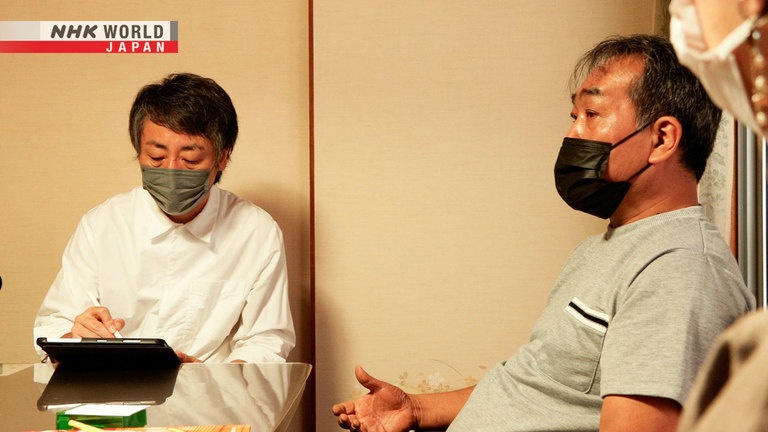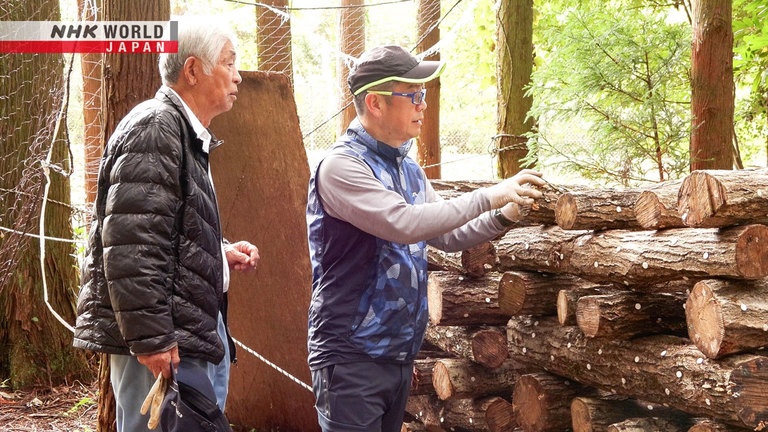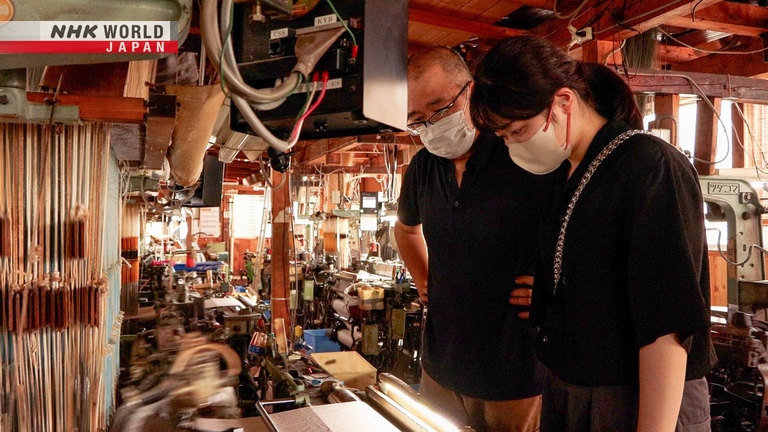Passing the Torch for Local Businesses: Matching Platform Developer - Asai Katsutoshi
Against the backdrop of an aging society, many of Japan's long-running small businesses, unattractive to investors and lacking obvious successors, are in danger of disappearance – particularly in provincial areas, where a vicious cycle of regional decline sees ever fewer families moving to such locations, further depleting the pool of potential successors. Asai Katsutoshi is fighting back, with a unique online service that matches such businesses with individuals keen to take on a new challenge.




Transcript
"RISING"
"Passing the Torch for Local Businesses"
Matching Platform Developer - Asai Katsutoshi
Kurashiki, Okayama Prefecture.
Long a hub for the textile industry,
it's known as Japan's leading producer of denim and other garments.
Local fabric cutter Tenno Yoshinori
specializes in school uniforms.
40 years of experience have given him an unparalleled expertise
in cutting fabric by hand.
This is my usual speed.
A machine might take four to five times as long.
With my left hand, I cut this way,
and with my right, it's like this.
It takes about five years to master this technique.
This approach cuts down on waste
and is also better suited than machines to cutting small lots.
Tenno can cut up to three times faster than a typical craftsperson.
But these skills that have underpinned the local textile industry
for so long are now at risk.
There's just nobody around anymore to carry on this approach.
Even a decade ago, there were four or five times as many craftspeople.
But it's not something I can counter on my own.
If we don't pass on these skills while we're still here,
they'll die out.
And across Japan,
there are countless such small and medium-sized businesses
facing closure because their owners can't find a successor.
By 2025,
there are expected to be over 2.4 million
small and medium-size business owners
over the typical retirement age of 70.
And around half of those businesses,
almost 1.3 million, are currently without a successor.
One person trying to address this issue is Asai Katsutoshi.
What we do is a little bit like mergers and acquisitions,
but we try and preserve firms for whom that approach won't work.
Asai creates profiles for businesses in search of successors.
Let's take a group photo.
Smile, Mr. President!
And these are used for an online service that matches such firms
with individuals nationwide with an interest in taking them over.
They include craft enterprises like Tenno's,
food and drink,
farming and more,
with sole operators as well as companies.
But this is no normal recruitment service.
The site carries company profiles with pictures and articles
that showcase the owners' character and ethos.
The town of Nanao, Ishikawa Prefecture
is located on the Noto Peninsula.
The area is recognized as a Globally Important Agricultural Heritage Site.
And it's also the home of another business for
whom Asai's service has been helping to find a successor.
In these woods is a shiitake mushroom farm.
Produce is grown on local "mizunara" oak logs,
and careful regulation of temperature and moisture
is the secret behind premium shiitake
that can sell for almost US 40 dollars per piece.
Though many local farmers dabble in shiitake growing during the winter months,
for Michida Teruo, it is a full-time calling.
I see shiitake as something that grows well in beautiful places.
Others might not see it that way, but I do.
It's a natural environment, but one I work hard on.
However, concerns about his ability
to match the physical demands of his work past the age of 70
lead him to Asai's matching service.
They started by advertising temporary positions
that would give respondents the chance to learn about shiitake growing.
And what Michida is hoping to find is someone who'll put their heart and soul
into carrying on his distinctive farming ethos.
One respondent was Takashima Eiji
who's been apprenticing with Michida since 2020.
A former pet shop owner
having handed over the reins to his own business and in search of a second career,
he happened across Asai's matching service.
I wanted to find some place I was needed
and a job for the long haul that only I could do.
I looked into all sorts of options, and eventually, I found this matching service.
And then when I met Michida-san,
it felt like destiny, and I decided to give it a go.
That's how it started.
I really admire his philosophy
that you get out what you put in.
It's great.
And I have to carry that on.
And now, Takashima is exploring new approaches
to promote the uncompromising expertise
that he found so inspiring in Michida.
To keep the farm going, we need a strong brand,
so I came up with a logo.
And I think that alone
has already made good on my pact as your successor. No?
There's a lot more to come from you yet.
And the pair are already beginning to make concrete arrangements for the succession
including transferring the deeds for the farm.
Back in the city of Okayama.
It's here that Asai Katsutoshi's matching service is based.
It's a compact operation with a team of only four.
In his previous career,
Asai was a CSR manager with a major music retailer.
Then in 2012, he moved to Okayama with his family
and turned his hand to promoting the area
and its produce to a wider audience.
And not content with promotional campaigns,
he later moved on to producing and selling
locally caught anchovies pickled in oil.
But while his initial plan was to start the business, then hand it over to someone local...
I couldn't find anyone to take over.
It was when I was trying to hand over my own small business
that I realized how hard it could be.
Around the same time,
his wife Asami wrote an article about business succession for a national magazine,
and Katsutoshi realized it was a nationwide problem.
It was a special
all about these businesses and the people who take them over,
and I began to feel that losing that kind of culture
would mean losing entire communities.
All these local areas I'd fallen in love with would just fade away.
I can see what's at stake, so I try to encourage him.
If nobody does anything,
all these small businesses with no successor will just disappear.
So I set out with the concept of building a platform
that could provide those businesses with the opportunity to find successors.
Mimasaka, Okayama Prefecture.
Here, another local business is preparing for the transition to a new owner,
thanks to Asai's service.
This business, with annual turnovers of some 26 million yen,
cultures freshwater fish for traditional "ryokan" menus
as well as running a family fishing area.
The opportunity for outdoor fun in a natural environment
attracts up to 10,000 visitors per year.
I want my kids to experience nature.
They don't usually have much chance to play out in nature.
It's great to do stuff here they can't do elsewhere.
Since 1971,
the enterprise has been run by Ute Nobuyuki
who started it with several friends.
I'm not physically up to it anymore.
At work, I can't lift heavy objects,
and I feel like I'm more likely to slip on narrow walkways.
I just can't keep up.
It's very tough work especially in rough weather.
When there's a typhoon coming, I have to work through the night.
I don't want to lay all that on my own kids.
Considering wrapping up the business,
he went to the local city hall for advice.
And determined to preserve this essential tourist resource,
in 2019, the local authorities launched a search for somebody to take over.
We wouldn't want to lose this place.
It's vital to us as a town.
But communications aren't the forte of local government.
We advertised the position but without any luck
because our only communications platform was the local website.
But after linking up with Asai-san's service as an external partner,
we soon found seven candidates.
It's been a major help.
After a year of searching,
in 2020, they turned to Asai's service in the hunt for a successor.
The conditions stipulated a three-year apprenticeship
as part of a local revitalization scheme
giving applicants a chance to learn about aquaculture and how to run the firm.
And one of seven respondents was Utsunomiya Kenji.
I saw the profile about this place on the matching service site,
and I thought, that's the job for me.
I felt we couldn't allow this business to close down
and deprive people of a place to fish.
After an interview, thanks to his passion for fishing
and flexibility to relocate as soon as possible,
Utsunomiya was chosen to be trained as Ute's successor.
When friends come here,
they say "What a great job you found. It's perfect for you."
I'd agree with them if I was just an employee.
But as the aspiring manager, it's not all fun and games.
Formerly an office worker with a manufacturing firm in neighboring Hyogo,
Utsunomiya had no prior experience of running a business.
So, as well as aquaculture,
he's also working hard to learn about business management.
This includes trying out business strategies of his own.
He's put particular energy into promoting the business via social media,
with encouraging results.
It's her first time fishing.
There's a lot of waiting, but it's fun when you get a bite.
It's my first time.
I've always wanted to try.
While the customer base had always been overwhelmingly male,
more women and couples are now coming to fish,
and sales have gone up by 30%.
Unlike my old job,
here, I think you have to constantly stay on your toes.
Things can change on a daily basis,
but that makes this work very rewarding.
I've resolved to make this my life's work,
and at this stage, I think I made the right decision.
I have to keep this business going.
It's now two years since Utsunomiya began his on-the-job training.
It's been a while.
And Asai drops by for a visit.
With the final handover drawing near, he's come to see how things are going.
This summer was a new record for fishing. Customers every day!
Some even mentioned how our fishes' fins looked prettier.
That reinforces the sense that our hard work is worth it.
And it's all thanks to you, Asai-san.
I wouldn't say that.
These encounters are really a question of luck.
Then it's just a case of whether the owner and successor get on.
You two are getting on great.
And the pair are now moving toward a transfer of shares,
plus Utsunomiya's installation as managing director.
Asai Katsutoshi's SME-focused spin on mergers
and acquisitions has some unique features.
Because conventional M&A specialists
focus on high-value enterprises that will generate more commission,
opportunities for small businesses are limited.
But Asai came up with a system that involves regional and municipal governments
who provide a regular subscription
that enables him to connect local businesses with aspiring successors.
At present, he has agreements with 11 separate locales.
And as well as helping to find immediate successors,
he also fosters the next generation
by recruiting for internships with small enterprises.
Kyotango, Kyoto Prefecture.
With 300 years of textile heritage,
this area produces some 60% of all Japan's kimono fabrics.
And this tradition is so strong
that textiles account for 75% of local manufacturing.
But with industry veterans aging and successors few and far between,
production has been declining year on year.
For the local authorities, it's a serious issue.
Kyotango has been shaped by its textile heritage,
so we can't just stand by and watch as the industry declines.
Businesses were traditionally handed down through families,
but now we feel we have to support the expansion of that pool.
Asai proposed a Kyotango-based internship scheme
that brought in outsiders to help consider ways
to preserve the knowhow of local craftspeople.
And now, five applicants chosen from all over Japan
are on placements with some of the town's many textile workshops.
My father created a way to weave mother-of-pearl.
You can see that here.
Tamiya Kyoji runs a textile workshop
founded by his father in 1975.
He welcomed Asai's internship scheme
as a chance to promulgate his father's textile innovations...
including one technique
for imbuing fabric with genuine mother of pearl.
These fabrics with a seashell-like iridescence
have won plaudits from around the world.
The assigned intern is Osaka-based designer Yoshizumi Eiko.
Is this green turban sea snail?
It is.
But the trick is to use little flecks of iridescence
in a deftly random way.
You need different angles.
So, without that variety, it feels boring?
That's right.
And this close-up look at Kyotango's workshops
deepens interns' interest in the local textile heritage.
This chance for a look behind the scenes,
at the trial and error behind the techniques,
and the creative freedom they enjoy has been very inspiring.
Meanwhile, at yet another workshop,
the instructor is Inoue Hajime,
third-generation head of this business founded in 1933.
The intern is Aoki Hirono,
a textile design student based in Tokyo.
She's brought in her own pattern to learn how it could be made on a loom.
With textiles, there are levels of precision that determine
whether a pattern like this would work or not.
Can we keep this bit?
Or do we need to round this bit off a little.
Of course, you won't spot those details unless you're looking for them,
but it's about one's own personal standards.
And for Aoki, the internship has helped to reinforce
her desire to pursue a long-term career in textiles.
I've been studying textiles,
but without actually seeing and experiencing this up close,
I didn't really "get" it.
Being able to see the process and experience it firsthand
has been a great learning experience.
But there's no quick fix for the preservation of traditional industries like this.
To Asai, it's a matter of consistent support.
It's great when you find a successor straight away,
but that's not the only issue.
To preserve these crafts,
it's also important to develop people
who can support these businesses externally to expand that base,
expand that community, that fan base.
That sort of stuff is very important.
But ultimately, we also need to make sure
there are people here to take over.
And that's a long process, but it's something we have to keep working on.
Many of the towns Asai works with are worried
about the future of their traditional craft industries.
One such location is Tsuyama, Okayama Prefecture.
Japan's "washi" paper heritage goes back over one thousand years,
and Ueda Shigeo's family has been in this tradition for six generations.
But this craft, too, faces a serious issue.
Aging among growers of washi's base ingredient,
the "mitsumata" paperbush plant.
Even if there are skilled washi makers,
without quality ingredients, you can't make good washi.
Washi is so central to Japanese culture
that its decline would be a disaster for this country.
That would spell an upsetting age for us all.
Close to Tsuyama is the town of Mimasaka.
It's home to seasoned mitsumata grower Ute Shinobu.
His family has been supplying Ueda Shigeo's for three generations.
If I retire,
there will be no one left to carry this on.
There used to be 30 or 40 farms around here,
but we're all that's left. Sad.
In 2022, the farm turned to Asai's service.
The first move was to organize mitsumata farming workshops.
These sessions, held at various points throughout the year,
give participants a chance to experience the many processes
that underpin mitsumata growing.
And the program attracted four interested parties
aged in their 20s to 40s.
I've been interested in the raw material of washi for a while,
and I saw the listing online.
I thought I'd like to get involved where I could,
so I came along.
I'd like to move to the country.
And when that happens, I think I'd like to do this sort of thing on the side.
That's why I decided to take part.
Today, Ute walks them through the planting of seedlings.
You bunch the roots together.
Cover with soil and stamp it down.
I can't do it like him.
If this group produces a willing successor,
Ute plans to begin by leasing them his land to entrust the task of growing.
If it is working out after three to five years,
I'll give them the land.
That way I can pass on my knowhow and the resources we have here.
But for that, we need someone young.
I'd like to see this carried on
forever.
It could be a style of farming that's unique to a specific location,
or a unique craft item or food.
Local small businesses underpin the uniqueness of each area,
and losing those would lead to homogenization.
I don't think we'll solve the issue of business succession in my lifetime.
So it's a question of how to raise awareness,
and how to bring more and more people along for the ride.
That's the main challenge.
Across Japan,
small businesses are an essential part of the local fabric,
and Asai Katsutoshi continues to aid their survival
by passing the torch to a new generation.